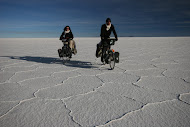The geology of Paine is exceptional. This mountain range offers not only an amazing landscape, but the sight of geologists sees something else. This bicolour mountain intrigues the tourists by its shape and colours and fascinates the geologists by its clarity.
We went trekking along what is called the W to explore the history of this mythical mountain. Seen from afar, the Paine includes several units. To the west, all black and covered with glaciers, the mountain of Paine Grande dominates all others, but does not show a particular shape. To the east, the towers attract tourists and the climbers from the entire world. They only consist of white rocks. Between the two, the cuernos (horns) proudly exhibit their two colours: the base consisting of black rocks like the relief of Paine Grande. Above, there are white rocks forming almost 1 km high vertical cliffs. Finally, the top of the horns is made of black rocks and shows a terrain more "soft" (less steep) than the cliffs.

 During the trekk we seek in vain to gain access to the mountains, but they are inaccessible. We merely observe boulder at the bottom of rivers. We found the white blocks that exhibit a coarse-grained texture that is typical of magmatic rocks cooled at depth (photo): it is granite. The black rocks are more diverse. Some are fairly homogeneous and other show strata (photos): These are sedimentary rocks. There are also very hard rocks. Looking closely, one sees that these rocks were re-crystallised, i.e. metamorphosed. As they are black, we assume that these rocks were originally the sediments, and they were metamorphosed when the granite was emplaced. If our hypothesis is valid, the sediments have been transformed by granite and the granite is younger than the sediments.
During the trekk we seek in vain to gain access to the mountains, but they are inaccessible. We merely observe boulder at the bottom of rivers. We found the white blocks that exhibit a coarse-grained texture that is typical of magmatic rocks cooled at depth (photo): it is granite. The black rocks are more diverse. Some are fairly homogeneous and other show strata (photos): These are sedimentary rocks. There are also very hard rocks. Looking closely, one sees that these rocks were re-crystallised, i.e. metamorphosed. As they are black, we assume that these rocks were originally the sediments, and they were metamorphosed when the granite was emplaced. If our hypothesis is valid, the sediments have been transformed by granite and the granite is younger than the sediments.


The texture and the structure of the sediments are quite simple, because they show layers parallel to each other. The sediments are formed at the bottom of oceans and are initially horizontal. However, in the massif of Paine, little sediments are horizontal. Some are bended, twisted or even vertical. In the landscape, it is possible to follow large structures thanks to strata. The sediments have been deformed by tectonic activity. However, our observations do not allow us to know the relative chronology between the emplacement of the granite and the deformation of sediments.

 Although we could not access the main granite, we observed small granite intrusions along the hiking track. For example, we observed a small sheet intrusion, about 10 meters thick. We can see that this intrusion is almost always parallel to the layers of sediments. However, locally, the vein cuts the sediment, which proves that it is younger than the sediments. Following the vein in the landscape, we realize that it is folded like the sediments. We thus conclude the intrusion of magma is older than the tectonic deformation.
Although we could not access the main granite, we observed small granite intrusions along the hiking track. For example, we observed a small sheet intrusion, about 10 meters thick. We can see that this intrusion is almost always parallel to the layers of sediments. However, locally, the vein cuts the sediment, which proves that it is younger than the sediments. Following the vein in the landscape, we realize that it is folded like the sediments. We thus conclude the intrusion of magma is older than the tectonic deformation.


